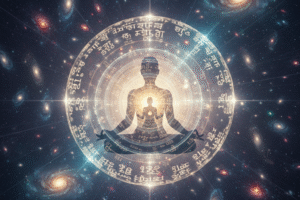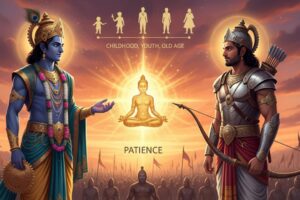
Karpanya Dosha,Prajna Vada
- Posted by Sri Kameswari Foundation
- Date August 29, 2025
- Comments 0 comment
Through this episode-6,we attempt to understand the different facets of our personality through the topics – Kārpaṇya Doṣa and Prajñā Vāda.
Kārpaṇya Doṣa
Svabhāvaḥ – Swasya Bhāvaḥ – This can be translated as the true nature of one’s own self. Each individual has a nature unique to them, which can sometimes be altered by the circumstances they encounter in life.
It often happens that negative tendencies within us get transformed in the face of challenges. At the same time, there is also the possibility that our good qualities become diminished under certain conditions. Among such tendencies, one of the most common we encounter in daily life is Kārpaṇya Doṣa (misery arising from selfish attachment or greed).
For example, as explained in the Satyanārāyaṇa Swāmy Vratam Kalpam, it is prescribed that based on one’s financial capacity, a devotee may use a gold, silver, or copper pratimā in the pūjā. However, with the thought that the pratimā will eventually be given to the priest (brāhmagāru) who recites the mantras, people often choose to use only silver, copper or even a one-rupee coin—despite their ability to offer more.
This tendency of self-limiting or acting out of narrow self-interest is what is called Kārpaṇyam (Lobham – greed).
Such flaws in our svabhāva can be dissolved only by surrendering completely to the embodiment of the Supreme—the Guru—just as Arjuna surrendered to Bhagavān Kṛṣṇa.
Prajñā Vāda
Arguing merely out of prejudice or preconceived notions, without looking at truth in its entirety, is called Prajñā Vāda. This is exactly what Arjuna did when he spoke at length about the long-term consequences of war. When individuals act out of such prejudice, they are described as mūḍha (deluded).
This tendency is something we often witness today in almost every discussion around us. Many of our interpretations—whether about our Itihāsa or our culture—are shaped more by prejudice than by true understanding. The real challenge before us is: how do we overcome these preconceived notions and move closer to reality?
The journey towards reality unfolds step by step, across different levels—some steps pertain to the individual, while others belong to the collective or societal domain.
It is always best to begin at the individual level. When we truly understand our own self, it naturally leads to an understanding of the outer world, for as our sages have taught: “Whatever is in the Brahmāṇḍa is also in the Piṇḍāṇḍa” (the microcosm and macrocosm mirror each other).
At the individual level, true knowledge is the discernment between Ātman and Anātman. This wisdom can only be attained through deep austerity (tapas), disciplined practice (anushṭhāna), and surrender to the Guru or God.
Through steadfast and pure anushṭhāna, carried out over time, one attains the wisdom of Ātman and Anātman, and learns to recognize this same truth operating in the outer world.
This post covers the concepts related to the sixth episode. Please click on the “Ch-2|Meaning of Shlokas 6-12” link in the Śrīmadbhagavadgītā Tattvamu home page to read the meaning,that has been explained in Episode-6.
You can also listen to this in Telugu from our Āchārya,Dr. Jammalamadaka Suryanārāyaṇa garu,by clicking the video below.
You may also like

Pratyabhijna,The Deeper Meaning of Antaha,Atma Tattvam

Ch-2|Meaning of Shlokas 15-17

